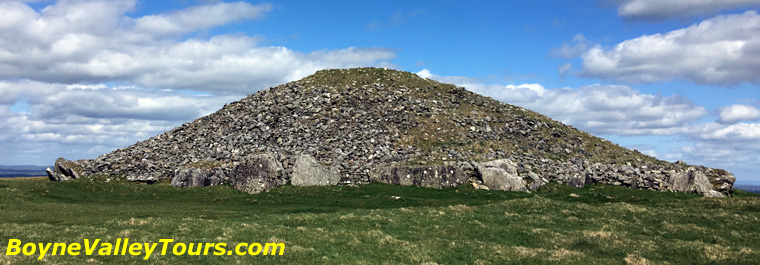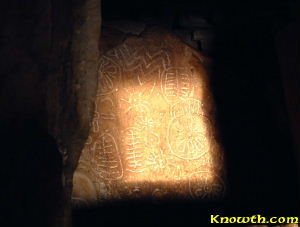 Clusters of Megalithic Cairns are dotted around the Slieve na Caillaigh hills at Loughcrew, the main
concentrations are on Carnbane East where Cairn T is the centrepiece and
Carnbane West where Cairn L is located.
Clusters of Megalithic Cairns are dotted around the Slieve na Caillaigh hills at Loughcrew, the main
concentrations are on Carnbane East where Cairn T is the centrepiece and
Carnbane West where Cairn L is located.
The illumination of the passage and chamber at the Winter solstice sunrise in Newgrange is world famous. Less well known is the Equinox illumination at sunrise in Cairn T at Loughcrew. The backstone of the chamber is illuminated by a beam of light at sunrise on the Spring and Autumnal Equinoxes.
The sun light is shaped by the stones of the entrance and passage and descends the backstone while moving from left to the right illuminating the solar symbols. Visitors are welcome to walk up Carnbane East to Cairn T, a ten minute walk up a grassy hill from a small car park. During the summer months there is a guide at Cairn T.
At Cairn L on Carnbane West the sunrise at Samhain (early November) and Imbolc (early February) illuminates the passage and chamber, lighting up the limestone standing stone in the cairn. The owner of the land where Cairn L is located does not allow public access to the site.
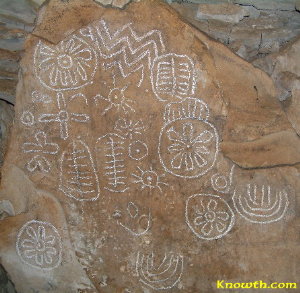
Equinox Stone - Loughcrew Cairn T
Cairn T or Hag's Cairn is of similar design to Newgrange. Traditionally described as a Passage Tomb, the wonderfully decorated backstone shows that the Cairn has a clear astronomical purpose.A beam of light from the rising sun around the time of the March and September equinoxes is mapped on the backstone of the Cairn. The event lasts for 50 minutes and was captured on video on the morning of March 23rd 2005, view a time lapse version of the Equinox Video (compressed form 50 minutes to 1:46).
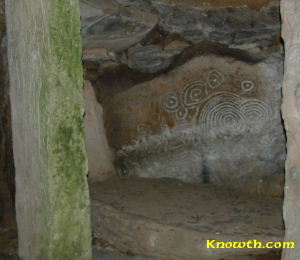
The interior of Cairn L
A freestanding limestone monolith or menhir is positioned inside the chamber (on the left of the image). Martin Brennan discovered that the six foot high monolith is a marker for the cross-quarter days Samhain (early November) and Imbolc (early February), when the sun illuminates the stone.Standing Stone in Loughcrew Cairn L
- Map and directions to Loughcrew.
- Loughcrew Cairns - Boyne Valley Tours.
- Loughcrew Equinox Reflection by Sally McKenna.
- Reflections on Loughcrew and Newgrange by Tim O'Brien.
- Artwork by Helen Gavigan, inspired by the cairns and engravings at Loughcrew.
- A taste of the unexpected: subverting mentalités through the motifs and settings of Irish passage tombs.
- Loughcrew Cairns as described in Vale of the Boyne and Royal Meath published in 1898 for the Great Northern Railway Company.
- Loughcrew Books including Loughcrew The Cairns a guide by Jean McMann.
- Megalithic Attractions of County Meath - Newgrange, Knowth, Dowth, Fourknocks, Loughcrew and Tara.
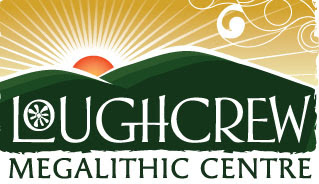 Loughcrew Megalithic Centre -
Family Run Megalithic Centre with coffee shop and original thatched house located near the car park
for stone age Cairns at Loughcrew. Hostel accommodation, camping facilities and heritage tours of Loughcrew Cairns available.
Loughcrew Megalithic Centre -
Family Run Megalithic Centre with coffee shop and original thatched house located near the car park
for stone age Cairns at Loughcrew. Hostel accommodation, camping facilities and heritage tours of Loughcrew Cairns available.
Loughcrew Cairns
In the rich farmlands of County Meath in Ireland’s Ancient East lies the Loughcrew Cairns, a passage tomb cemetery near the village of Oldcastle. Dominating the summits of three hills — Carnbane West, Carnbane East and Patrickstown. These stone age cairns, particularly Cairn T on Carnbane East, stand as prominent features, creating an archaeological marvel.Cairn T, dating back to around 3000 BC, holds sway on Carnbane East's summit, surrounded by smaller tombs. With a diameter of 115 feet (35 meters), this passage tomb boasts a cruciform shaped chamber adorned with exquisite megalithic art. During the autumn and spring equinoxes, sunlight filters into the chamber, illuminating the tomb's interior.
In the realm of Irish ancient sites, Loughcrew is a hidden gem. Unlike bustling Newgrange, Loughcrew offers a more intimate encounter with Neolithic passage-tomb builders. Unfortunately, structural issues have closed access to the interior of Cairn T.
Amid the kerbstones surrounding Cairn T, the Hag's Chair was used as a Mass Rock during penal times. This stone seat is also believed to have served ceremonial or inauguration purposes during the early medieval period.
Loughcrew's Irish name, Slieve na Calliagh, meaning 'The Hill of the Witch,' carries fascinating folklore. Legend has it that the cairns at Loughcrew originated when a witch, An Cailleach Bhéara, dropped stones on the three peaks. Despite succeeding on the first two, she missed the third and met her demise, an enduring tale etched in the stones of Loughcrew, where history, myth, and nature converge.
Boyne Valley Private Day Tour
 Immerse yourself in the rich heritage and culture of the Boyne Valley with our full-day private tours.
Visit Newgrange World Heritage site, explore the Hill of Slane, where Saint Patrick famously lit the Paschal fire.
Discover the Hill of Tara, the ancient seat of power for the High Kings of Ireland.
Book Now
Immerse yourself in the rich heritage and culture of the Boyne Valley with our full-day private tours.
Visit Newgrange World Heritage site, explore the Hill of Slane, where Saint Patrick famously lit the Paschal fire.
Discover the Hill of Tara, the ancient seat of power for the High Kings of Ireland.
Book Now
Home
| Newgrange
| Knowth
| Dowth
| Hill of Tara
| Fourknocks
| Loughcrew
| More Places
| Labyrinths
| Local Info
| Art Works
| Articles
| Images
| Books
| Links
| Boyne Valley Tours
| Contact

